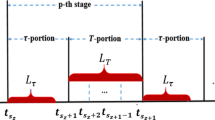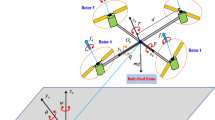Abstract
This paper presents a nonlinear equivalent-input-disturbance (NEID) approach to rejecting an unknown exogenous disturbance in a nonlinear system. An NEID compensator has two parts: a conventional equivalent-input-disturbance estimator and a nonlinear state feedback term. This design ensures that only the exogenous disturbance is rejected and the useful nonlinearity of the system is retained. Unlike other active disturbance-rejection methods, a Lipschitz condition is not necessary to guarantee the convergence of the observation error. Analysis of control performance provides upper bounds for the evaluation of disturbance rejection and the degree of nonlinearity retention. Numerical examples show the validity and superiority of this method.








Similar content being viewed by others
References
Hassan, M.F., Hammuda, M.: A new approach for constrained chaos synchronization with application to secure data communication. J. Frankl. Inst. 356, 6697–6723 (2019)
Li, P., Dai, C., Zhang, D., Yang, Y.: Imperfect bifurcations in an initially curved plate loaded by incompressible axial airflow. Nonlinear Dyn. (2019). https://doi.org/10.1007/s11071-019-05360-4
Goldberger, A.L.: Applications of chaos to physiology and medicine. In: Kim, J.H., Stringer, J. (eds.) Applied Chaos, pp. 321–331. Wiley, New York (1992)
Ottino, J.M.: The Kinematics of Mixing: Stretching, Chaos, and Transport. Cambridge University Press, New York (1989)
Schiff, S.J., Jerger, K., Duong, D.H., Chang, T., Spano, M.L., Ditto, W.L.: Controlling chaos in the brain. Nature 370, 615–620 (1994)
Li, S., Ma, X., Biao, X., Lai, S.K., Zhang, W.: Suppressing homoclinic chaos for a weak periodically excited non-smooth oscillator. Nonlinear Dyn. (2019). https://doi.org/10.1007/s11071-019-05380-0
Chen, G., Lai, D.: Anticontrol of chaos via feedback. In: Proceedings of the 36th IEEE Conference on Decision ANC Control. San Diego, CA (1997)
Moradi, H., Vossoughi, G.: Multivariable control of the bifurcation and harmonic perturbations to improve the performance of air-handling units. ISA Trans. 60, 119–127 (2016)
Chen, W.H., Ballance, D.J., Gawthrop, P.J., O’Reilly, J.: A nonlinear disturbance observer for robotic manipulators. IEEE Trans. Ind. Electron. 47(4), 932–938 (2000)
Chen, W.H.: Harmonic disturbance observer for nonlinear systems. J. Dyn. Syst. Meas. Control 125(1), 114–117 (2003)
Kim, K.S., Rew, K.H., Kim, S.: Disturbance observer for estimating higher order disturbances in time series expansion. IEEE Trans. Autom. Control. 55(8), 1905–1911 (2010)
Song, J., Niu, Y., Zou, Y.: Finite-time stabilization via sliding mode control. IEEE Trans. Autom. Control. 62(3), 1478–1483 (2017)
Mobayen, S., Baleanu, D.: Stability analysis and controller design for the performance improvement of disturbed nonlinear systems using adaptive global sliding mode control approach. Nonlinear Dyn. 83, 1557–1565 (2016)
Bai, W., Zhou, Q., Li, T., Li, H.: Adaptive reinforcement learning neural network control for uncertain nonlinear system with input saturation. IEEE Trans. Cybernet. (2019). https://doi.org/10.1109/TCYB.2019.2921057
Yang, H., Liu, J.: An adaptive RBF neural network control method for a class of nonlinear systems. IEEE/CAA J. Autom. Sin. 5(2), 457–462 (2018)
Sun, Z.Y., Shao, Y., Chen, C.C.: Fast finite-time stability and its application in adaptive control of high-order nonlinear system. Automatica 106, 339–348 (2019)
Chen, B.S., Tsang, C.S., Uang, H.J.: Mixed \(H_2/H_\infty \) fuzzy output feedback control design for nonlinear dynamic systems: an LMI approach. IEEE Trans. Fuzzy Syst. 8(3), 249–265 (2000)
Liu, C., Li, H., Gao, J., Xu, D.: Robust self-triggered min-max model predictive control for discrete-time nonlinear systems. Automatica 89, 333–339 (2018)
Ohishi, K., Nakao, M., Ohnishi, K., Miyachi, K.: Microprocessor-controlled dc motor for load-insensitive position servo system. IEEE Trans. Ind. Electron. 34(1), 44–49 (1987)
Ding, S.H., Chen, W.H., Mei, K., Murray-Smith, D.J.: Disturbance observer design for nonlinear systems represented by input-output models. IEEE Trans. Ind. Electron. 67(2), 1222–1232 (2020)
Han, J.: From PID to active disturbance rejection control. IEEE Trans. Ind. Electron. 56(3), 900–906 (2009)
Ran, M., Wang, Q., Dong, C.: Active disturbance rejection control for uncertain nonaffine-in-control nonlinear systems. IEEE Trans. Autom. Control 62(11), 5830–5836 (2017)
Huang, Y., Xue, W.: Active disturbance rejection control: methodology and theoretical analysis. ISA Trans. 53(4), 963–976 (2014)
She, J., Fang, M.X., Ohyama, Y., Kobayashi, H., Wu, M.: Improving disturbance-rejection performance based on an equivalent-input-disturbance approach. IEEE Trans. Ind. 55(1), 380–389 (2008)
Sakthivel, R., Kaviarasan, B., Selvaraj, P., Karimi, H.R.: EID-based sliding mode investment policy design for fuzzy stochastic jump financial systems. Nonlinear Anal. Hybrid Syst. 31, 100–108 (2019)
Zhai, J., Karimo, H.R.: Universal adaptive control for uncertain nonlinear systems via output feedback. Inf. Sci. 500, 140–155 (2019)
Chagra, W., Degachi, H., Ksouri, M.: Nonlinear model predictive control based on Nelder Mead optimization method. Nonlinear Dyn. 92, 127–138 (2018)
Persis, C.D., Jayawardhana, B.: On the internal model principle in the coordination of nonlinear systems. IEEE Trans. Control Netw. Syst. 1(3), 272–282 (2014)
Chen, W., Yang, J., Guo, L., Li, S.: Disturbance-observer-based control and related methods-an overview. IEEE Trans. Ind. Electron. 632, 1083–1095 (2016)
Gao, F., Wu, M., She, J., Cao, W.: Disturbance rejection in nonlinear systems based on equivalent-input-disturbance approach. Appl. Math. Comput. 282, 244–253 (2016)
She, J., Xin, X., Pan, Y.: Equivalent-input-disturbance approach-analysis and application to disturbance rejection in dual-stage feed drive control system. IEEE/ASME Trans. Mechatron. 16(2), 330–340 (2011)
Khalil, H.K.: Nonlinear Systems, 3rd edn. Prentice-Hall, Upper Saddle River (2002)
Doyle, J.C., Francis, B.A., Tannenbaum, A.R.: Feedback Contorl Theory. Courier Corporation, North Chelmsford (2013)
Acknowledgements
This work was supported in part by the National Key R&D Program of China under Grant 2017YFB1300900; the National Natural Science Foundation of China under Grant 61873348; the Hubei Provincial Natural Science Foundation of China under Grant 2015CFA010; and the 111 Project, China under Grant B17040.
Author information
Authors and Affiliations
Corresponding author
Ethics declarations
Conflict of interest
The authors declare that they have no conflict of interest regarding the publication of this paper.
Additional information
Publisher's Note
Springer Nature remains neutral with regard to jurisdictional claims in published maps and institutional affiliations.
Appendix
Appendix
Stability of the NEID-based disturbance-rejection system for (4) is analyzed below.
The state-space representation of the NEID-based disturbance-rejection system is
where
If \(\bar{A}\) is Hurwitz, then, for any positive-definite symmetric matrix K, the solution, \(P_g\), of
is positive definite. Let
be a Lyapunov function candidate of (A.1). The derivative of \(V_g(\xi (t))\) along the trajectories of (A.1) is given by
where
Since
and
(A.4) becomes
where \(\theta _1,~\theta _2,~\theta _3\) are positive numbers and
It is easy to check that there exist positive numbers \(\theta _1,~\theta _2,~\theta _3\), such that
is true. Thus,
which means that the NEID-based disturbance-rejection system is global uniformly boundedness for (4).
Rights and permissions
About this article
Cite this article
Yin, X., She, J., Wu, M. et al. Disturbance rejection and performance analysis for nonlinear systems based on nonlinear equivalent-input-disturbance approach. Nonlinear Dyn 100, 3497–3511 (2020). https://doi.org/10.1007/s11071-020-05699-z
Received:
Accepted:
Published:
Issue Date:
DOI: https://doi.org/10.1007/s11071-020-05699-z




